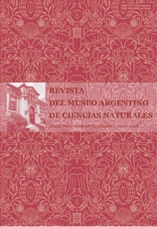Estratigrafía del Grupo Neuquén, Cretácico Superior de la Cuenca Neuquina (Argentina): nueva propuesta de ordenamiento litoestratigráfico
Resumen
Stratigraphy of the Neuquén Group, Upper Cretaceous of the Neuquén Basin (Argentina):
new proposal for lithostratigraphic ordaining. The Neuquén Group conform a succession of non-marine
deposits of fluvial, aeolian and shallow lacustrine origin, developed in the Neuquén Basin between the Lower
Cenomanian and the Middle Campanian (Upper Cretaceous). This succession reaches 1,200 m of maximum thick,
being bounded at the base and the top by the Patagonidican and Huantraiquican unconformities respectively.
In this paper two new formations are proposed (Los Bastos and Sierra Barrosa Formations, nom. nov.), and the
subgroups were reconfigurated. Consequently, the Neuquén Group is composed lithostratigraphically by three
subgroups and nine formations. The Río Limay Subgroup comprehend the Candeleros and Huincul Formations,
representing low sinuosity channel deposits developed under tectonic and climatic subordinated control. The
Río Neuquén Subgroup comprehend to the Cerro Lisandro, Portezuelo, Los Bastos, Sierra Barrosa and Plottier
Formations, conforming a psamitic and pelitic interstratified succession of fluvial origin, mainly developed under
climatic control. Finally, the Río Colorado Subgroup integrated by the Bajo de la Carpa and Anacleto Formations,
comprehend fluvial deposits developed under a new dominant tectonic control. At the start of the deposition of the
Neuquén Group, the Dorsal de Huincul worked as a structural high, generating toward the south of the Neuquén
Basin one a small endorreic depocentre corresponding to the Picún Leufú Sub-basin, scheme that would have been
keep up to ends of the deposit of the Candeleros Formation. During the rest of the deposit of this sequence, the
drainage would have been kept without major modifications towards the pacific slope across a central collector
flowing in sense N-NW. Towards the end of the deposit of the Neuquén Group takes place the inversion of the
regional slope of the basin, making possible the ingression of the Atlantic Ocean and the beginning of the deposition
of the Malargüe Group.
Key words: Neuquén Group, new
new proposal for lithostratigraphic ordaining. The Neuquén Group conform a succession of non-marine
deposits of fluvial, aeolian and shallow lacustrine origin, developed in the Neuquén Basin between the Lower
Cenomanian and the Middle Campanian (Upper Cretaceous). This succession reaches 1,200 m of maximum thick,
being bounded at the base and the top by the Patagonidican and Huantraiquican unconformities respectively.
In this paper two new formations are proposed (Los Bastos and Sierra Barrosa Formations, nom. nov.), and the
subgroups were reconfigurated. Consequently, the Neuquén Group is composed lithostratigraphically by three
subgroups and nine formations. The Río Limay Subgroup comprehend the Candeleros and Huincul Formations,
representing low sinuosity channel deposits developed under tectonic and climatic subordinated control. The
Río Neuquén Subgroup comprehend to the Cerro Lisandro, Portezuelo, Los Bastos, Sierra Barrosa and Plottier
Formations, conforming a psamitic and pelitic interstratified succession of fluvial origin, mainly developed under
climatic control. Finally, the Río Colorado Subgroup integrated by the Bajo de la Carpa and Anacleto Formations,
comprehend fluvial deposits developed under a new dominant tectonic control. At the start of the deposition of the
Neuquén Group, the Dorsal de Huincul worked as a structural high, generating toward the south of the Neuquén
Basin one a small endorreic depocentre corresponding to the Picún Leufú Sub-basin, scheme that would have been
keep up to ends of the deposit of the Candeleros Formation. During the rest of the deposit of this sequence, the
drainage would have been kept without major modifications towards the pacific slope across a central collector
flowing in sense N-NW. Towards the end of the deposit of the Neuquén Group takes place the inversion of the
regional slope of the basin, making possible the ingression of the Atlantic Ocean and the beginning of the deposition
of the Malargüe Group.
Key words: Neuquén Group, new
Texto completo:
PDFEnlaces refback
- No hay ningún enlace refback.

This work is licensed under a Creative Commons Attribution 3.0 License.

